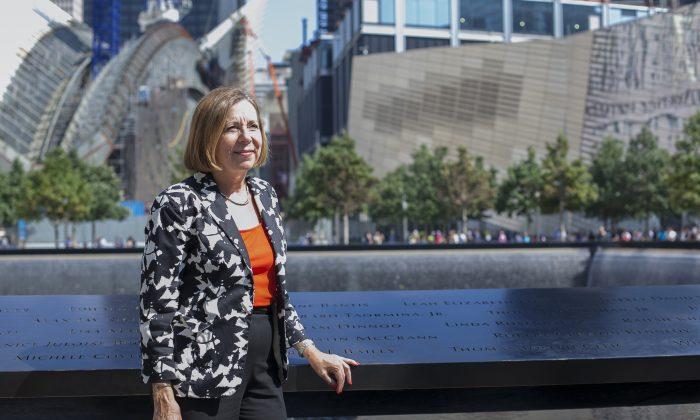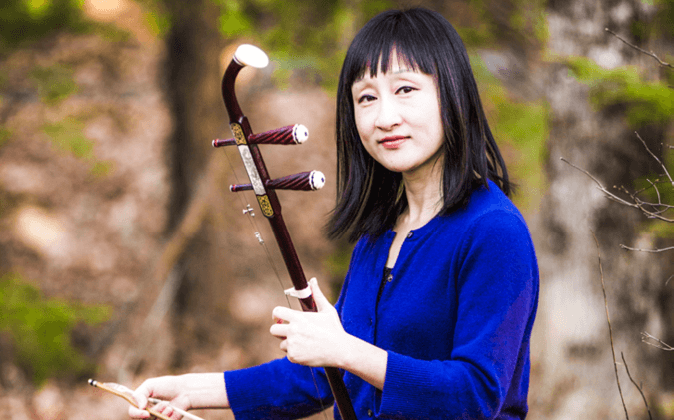NEW YORK—There’s the survivors’ staircase. A remnant of the Vesey Street stairs that hundreds used to escape infamy on the morning of Sept. 11, 2001. In an uncanny, vicarious way, one descends the steps alongside the artifact to enter the 9/11 Memorial Museum’s underground exhibitions. Inside, within every few steps, there is a reminder of terror: a piece of contorted steel; a mangled fire truck; a wiry elevator motor that once lifted workers up to skyscrapers, now lifeless, rusting. And for the umpteenth time, Alice Greenwald walks through the exhibits.
To survive as the director of the 9/11 Memorial Museum, Greenwald retains a strong belief in the human capacity to be good.
She goes two stories above the exhibits to the cafe, a simplistically designed space lit purely by late afternoon sunlight. Her pearl-shaped eyes scan the room and rest on the One World Trade Center, looming outside the window.
“This is ground zero for what we build up, not what came down,” she said.
When asked what is her response to the criticism of opening a cafe on a site of mass murder, she said, quite simply, that it’s a place to gather one’s thoughts before or after a visit.
And as for the criticized gift shop, she said, it is a practical solution to maintaining a free public space that receives no public funding.
“Someone has to make sure the trees are irrigated, the waterfalls are clean, and the filters are working,” she said.

She goes on to talk about the museum with an unassumed dignity. The museum is a documentation of a horrific event, she said, but it doesn’t stop at the event.
“Life presents us always with unanticipated challenges, and you have a choice as a human being how you are going to respond to the events you are compelled to deal with,” she said. “How we respond tells us what kind of a human being we are.”
A part of the museum’s collection consists of records of simple acts of kindness: a teenager who brought cookies to the recovery crew, a podiatrist who volunteered to give foot massages to first responders, each day, for nine months.
Public Reaction Thus Far
The transition from conception and planning to public opening has been weird and wonderful.
Greenwald spent eight years agonizing over the endless minutia of what reaction the shade of a color, the volume of a voice, or the size of a picture would invoke in a visitor.
“It’s a funny thing to transition from being here without the public … to seeing the look on their faces,” she said. “It has transformed the way I see the museum.”
There were incessant debates over the controversial aspects of the museum, such as the repository of remains, and a video explaining al-Qaeda.
“When you’re dealing with commemoration of mass murder or atrocity,” she said, “there will inevitably be multiple, simultaneous special interests among different stakeholders in the project.”
“But our mission is to educate and commemorate,” she said.
Greenwald has experienced this before. She was previously the associate museum director at the U.S. Holocaust Memorial Museum in Washington, D.C.
Greenwald has seen the Holocaust museum through its inception, construction, and the creation of its permanent exhibition; if anyone, she would be prepared for what to expect at the 9/11 Memorial Museum.
There was one thing she did not expect, though, and it was the time that people took to leave a thoughtful, personal message at the interactive booths.
“I would have probably guessed that 5 percent of the public will stop there because they’re tired,” Greenwald said. “But I’m surprised; a huge percentage of our visitors stop to write poignant messages.”
Leaving Notes
More than 80,000 visitors have left electronic notes of remembrance in the museum’s largest gallery, the Foundation Hall, where visitors can write their thoughts on a digital registry beside a recovered piece of steel.
Some registry notes listed on the 9/11 Memorial Museum blog include:
“Joshua, you are with us always, Love you and miss you, Mother / Miss ya Bro!! Brian.”
“We all miss you Sarah Khan, from mom and family,” from Mabaruma, Guyana.
“You will always be in memory,” from Chongqing, China.

So far, the museum has received signatures from 170 countries.
More than 930,000 people have visited the museum so far; there are around 8,000–9,000 people visiting each day, according to Anthony Guido, the museum’s communications manager.
“I think of myself going into a booth, and answering a substantive question in front of a count down clock, and I'd be fumbling and mumbling,” Greenwald said. “But the degree of thoughtful, articulate responses we’re getting is an indication of how deeply 9/11 still affects people.”
In Memoriam
To this day, Greenwald will find herself stopping to listen to the audio in the In Memoriam exhibition, which commemorates the 2,982 men, women, and children who were killed during the terrorist attacks of 2001, and the 1993 World Trade Center bombing.
Their portraits fill a large room. There is a small, dark room in the center, where visitors sit above a transparent floor with pebbles and dirt underneath.
There, one-by-one, an audio plays to remember victims. The narrations are recorded by a family member or a friend, as he or she recalls anecdotes about the person’s personality, hobbies, and dreams. The remembrance audio is simple, but it brings grown men to sniffle.
Afterward, Greenwald often takes a moment to stop by the museum’s theater, adjacent to the In Memoriam exhibition. She watches the people who leave the theater with tears in their eyes, after viewing a 10-minute immersion film called “Rebirth at Ground Zero,” which documents how people joined together to rebuild the site.
“It takes you from a place of sadness and shock to a place of possibility and potential,” Greenwald said. “The way people responded to the worst of humanity exemplified the best of what we can be.”

This Is New York is a weekly feature that delves into the life of an inspiring individual in New York City. Read a new feature every Saturday online, and every Friday in print. See all our TINYs here: epochtim.es/TINY





